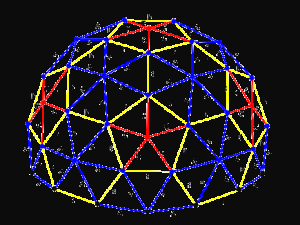
 Alumnus John Hurt’s unique donations of geodesic domes to the MTSU aerospace and biology departments will aid unmanned aircraft systems and spider research for students and faculty. Hurt, a member of the Class of ’82, owns Buffalo Valley, Tennessee-based Zip Tie Domes, which makes 10- to 25-foot structures primarily used for chicken coops and greenhouses.
Alumnus John Hurt’s unique donations of geodesic domes to the MTSU aerospace and biology departments will aid unmanned aircraft systems and spider research for students and faculty. Hurt, a member of the Class of ’82, owns Buffalo Valley, Tennessee-based Zip Tie Domes, which makes 10- to 25-foot structures primarily used for chicken coops and greenhouses.
Here’s the genius: The domes are constructed with 1.5-inch PVC pipe. Stainless steel zip ties hold adjoining ends together, and once the top is added, the dome becomes a solid piece!
Aerospace’s unmanned aircraft systems, or drone, program will use the dome for testing and evaluation purposes in the enclosed environment, said Doug Campbell, who manages the UAS program. MTSU associate professor Ryan Otter and his biology students will be able to utilize two 10-foot Zip Tie Domes for spider research starting this spring. (MTSU file photo by J. Intintoli)
“When we apply to the Federal Aviation Administration for permission to fly our unmanned aircraft out here, the first thing we have to ensure is that the aircraft is air-worthy,” Campbell said.
“Doing air-worthiness evaluation, doing the hover checks, doing build checks on aircraft we’ve constructed either from kits or individual components and sharing that that build is of sufficient quality to be air-worthy is the objective.”
Development Director Nicole Chitty said the College of Basic and Applied Sciences is excited that the domes have been given to the aerospace and biology departments.
“The domes will be a tremendous help to students in these aerospace and biology programs,” she said.
Otter said the biology department will use the domes as “artificial habitats for use in our field work” related to theDecember 2008 Kingston, Tennessee, coal ash spill.
“In my lab, we work with spiders that live at the edges of rivers and lakes, and when we collect spiders, we look on the tree branches that overhang the water,” Otter explained.
“With these domes, we are hoping to build artificial habitats that spiders will use, so we improve our collection efficiency. We are very optimistic and think they can really help us in our field research.”.
For the Full article click here














